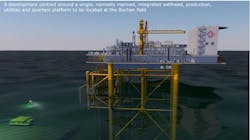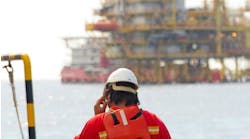Offshore staff
LONDON – Jersey Oil & Gas has issued results from a concept select peport (CSR) for its Greater Buchan Area (GBA) development in the UK central North Sea.
The project, targeting 172 MMboe of light, sweet crude and associated gas, is designed to resume production from the shut-in Buchan oil field and to produce the J2, Verbier and other nearby oil discoveries.
JOG plans a three-phase development. Phase 1 involves construction of a normally manned, integrated wellhead, production, utilities and quarters platform located over Buchan.
Production will be supported by injection of produced water and seawater. A heavy-duty jackup will drill the wells from a 12-slot well bay.
Phase 1 facilities will also accommodate production from the Phase 2 development of J2 West, J2 East and Verbier East via a subsea tieback to the GBA platform; and Phase 3, Verbier West, via a connection to the Phase 2 subsea infrastructure. Anticipated field life is 31 years.
JOG plans to export production through nearby pipeline infrastructure for oil and gas, with the FEED likely to start later this year.
Another focus has been on the optimum type of artificial lift for the production wells. Use of electrical submersible pumps (ESPs) indicated a higher production rate, and therefore higher recoverable volumes, compared with gas-lifted wells.
JOB estimates Phase 1 capex at around £1 billion ($1.39 billion), with opex during over three years of plateau production in the range $8-9/boe, and total project costs close to $30/boe.
The company has also examined options to eliminate carbon-dioxide emissions associated with power generation on the platform, with power imported from the UK national grid via a subsea cable from shore.
This would render unnecessary some rotating equipment and supporting utilities such as fuel gas treatment equipment. And a fully electrified platform would avoid the need for conventional utility systems such as instrument air, lowering capex of the topsides facilities and associated opex due to lessened maintenance.
Finally, removing the need to use associated gas as fuel should increase gas export revenues. However, the cost reductions would be partly offset by the cost of the grid connection and subsea cable and the in-service purchase price of electricity.
Overall carbon emissions from the GBA with platform electrification appear to be <1kg/boe, compared with estimated 13kg/boe for a development using gas turbines of 13kg/boe. The average for the UK continental shelf is around 20kg/boe, JOG added.
There is also potential for the development to be an enabler for wider regional electrification. Collaboration with other operators could cut the capital costs associated with the cable infrastructure.
In parallel with the GBA concept select phase, collaborative studies have identified potential for synergies with nearby third party-discovered resources, produced through the platform.
JOG expects to submit a separate concept select report to Britain’s Oil and Gas Authority by July 31, 2021. Work continues on tenders for marine surveys to support the environmental statement required for the development plan, and tendering processes are also under way for the provision of FEED engineering services.
The current goal is to start the project’s FEED phase this summer, followed by FID in H2 2022.
03/03/2021



